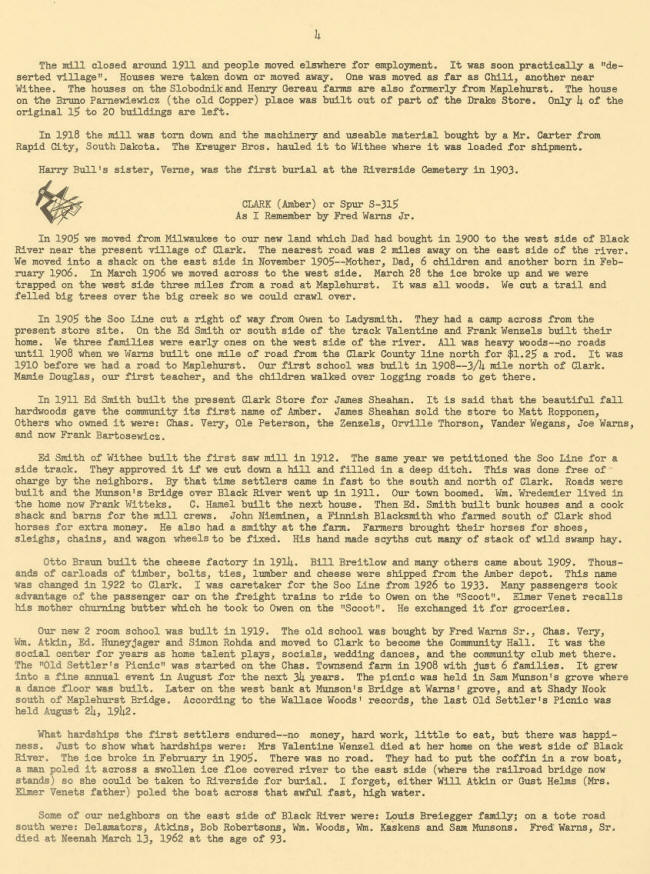|
[Memory
Trails Index]
Transcription
Janet Schwarze
The mill closed around
1911 and people moved elsewhere for employment. It was soon practically a “deW
serted village”. Houses were taken down or moved away. One was moved as far as
Chili, another near Withee. The houses on the Slobodnik and Henry Gereau farms
are also formerly from Maplehurst. The house on the Bruno Parneidewicz (the old
Copper) place was built out of part of the Drake Store. Only 14 of the original
15 to 20 buildings are left.
In 1918 the mill was torn down and the machinery and useable material bought by
a Mr. Carter from Rapid City, South Dakota. The Kreuger Bros. hauled it to
Withee where it was loaded for shipment.
Harry Bull’s sister, Verne, was the first burial at the Riverside Cemetery in
1903.
CLARK (Amber) or Spur S-315
As I Remember by Fred Warns Jr.
In 1905 we moved from Milwaukee to our new land which Dad had bought in 1900 to
the west side of Black River near the present village of Clark. The nearest road
was 2 miles away on the east side of the river. We moved into a shack on the
east side in November 1905--Mother, Dad, 6 children and another born in February
1906. In March 1906 we moved across to the west side. March 28 the ice broke up
and we were trapped on the west side three miles from a road at Maplehurst. It
was all woods. We cut a trail and felled big trees over the big creek so we
could crawl over.
In 1905 the Soo Line cut a right of way from Owen to Ladysmith. They had a camp
across from the present store site. On the Ed Smith or south side of the track
Valentine and Frank Wenzels built their home. We three families were early ones
on the west side of the river. All was heavy woods-—no roads until 1908 when we
Warns built one mile of road from the Clark County line north for $1.25 a rod.
It was 1910 before we had a road to Maplehurst. Our first school was built in
l9O8--3/14 mile north of Clark. Mamie Douglas, our first teacher, and the
children walked over logging roads to get there.
In 1911 Ed Smith built the present Clark Store for James Sheahan. It is said
that the beautiful fall hardwoods gave the community its first name of Amber.
James Sheahan sold the store to Matt Ropponen, Others who owned it were: Chas.
Very, Ole Peterson, the Zenzels, Orville Thorson, Vander Wegana, Joe Warns, and
now Frank Bartosewjcz.
Ed Smith of Withee built the first saw mill in 1912. The same year e petitioned
the Soo Line for a side track. They approved it if we cut down a hill and filled
in a deep ditch. This was done free of charge by the neighbors. By that tine
settlers came in fast to the south and north of Clark. Roads were built and the
Munson’s Bridge over Black River went up in 1911. Our town boomed. Wm. Wredemier
lived in the home now Frank Witteks. C. Haniel built the next house. Then Ed.
Smith built bunk houses and a cook shack and barns for the mill crews. John
Nieminen, a Finnish Blacksmith who farmed south of Clark shod horses for extra
money. He also had a smithy at the farm. Farmers brought their horses for shoes,
sleighs, chains, and wagon wheels to be fixed. His hand made scythe cut many of
stack of wild swamp hay.
Otto Braun built the cheese factory in 19114. Bill Breitlow and many others came
about 1909. Thousands of carloads of timber, bolts, ties, limiber and cheese
were shipped from the Amber depot. This name was changed in 1922 to Clark. I was
caretaker for the Soo Line from 1926 to 1933. Many passengers took advantage of
the passenger car on the freight trains to ride to Owen on the “Scoot”. Elmer
Venet recalls his mother churning butter which he took to Owen on the “Scoot”.
He exchanged it for groceries.
Our new 2 room school was built in 1919. The old school was bought by Fred Warns
Sr., Chas. Very, Wet. Atldn, Ed. Huneyjager and Simon Rohda and moved to Clark
to become the Community Hall. It was the social center for years as home talent
plays, socials, wedding dances, arid the community club met there. The “Old
Settler’s Picnic” was started on the Chas. Townsend farm in 1908 with just 6
families. It grew into a fine annual event in August for the next 314 years. The
picnic was held in Sam Munson’s grove where a dance floor was built. Later on
the west bank at Munson’s Bridge at Warns’ grove, and at Shady Nook south of
Naplehurst Bridge. According to the Wallace Woods’ records, the last Old
Settler’s Picnic was held August 24, 1942.
What hardships the first settlers endured—-no money, hard work, little to eat,
but there was happiness. Just to show what hardships were: Mrs. Valentine Wenzel
died at her home on the west side of Black River. The ice broke in February in
1905. There was no road. They had to put the coffin in a row boat, a man poled
it across a swollen ice floe covered river to the east side (where the railroad
bridge now stands) so she could be taken to Riverside for burial. I forget,
either Will Atkin or Gust Helms (Mrs. Elmer Venet's father) poled the boat
across that awful fast, high water.
Some of our neighbors on the east side of Black River were: Louis Breiegger
family; on a tote road south were: Delamators, Atkins, Bob Robertsons, Wm.
Woods, Wm. Kaskens and Sam Munsons. Fred Warns, Sr. died at Neenah March 13,
1962 at the age of 93.
[Next]
[Memory
Trails Index]
|
